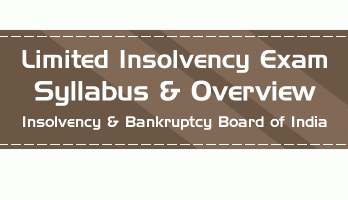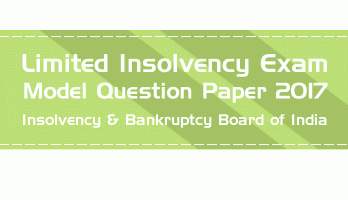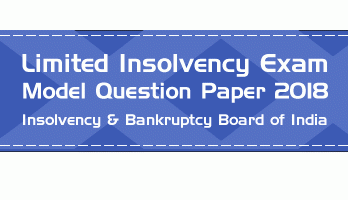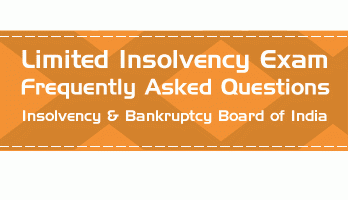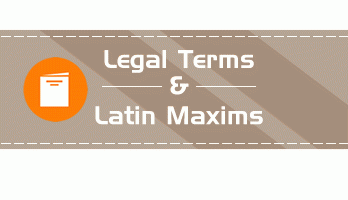51. In a Fast Track Insolvency Resolution Process, the fast track process costs do not include
(a) the amount of any interim finance and the costs incurred in raising such finance.
(b) the expenses on public announcement not ratified by the committee of creditors.
(c) the cost incurred by the resolution professional in running the business of the corporate debtor as a going concern.
(d) the amount due to suppliers of essential goods and services.
Ans. (b)
52. An order of the IBBI directing an inspecting authority to conduct an inspection of records of a service provider may not contain
(a) scope of inspection
(b) privileges of service provider
(c) composition of inspecting authority
(d) timelines for conducting the inspection
Ans. (b)
53. Who is empowered to pass an interim order on consideration of interim investigation report against an insolvency professional agency?
(a) Chairperson of the IBBI
(b) Investigating Authority
(c) Disciplinary Committee
(d) Adjudicating Authority
Ans. (c)
54. A show-cause notice issued by the IBBI on consideration of an inspection report needs to be disposed of by within
(a) Inspecting Authority, Six months.
(b) IBBI, Three months
(c) Adjudicating Authority, One year
(d) Disciplinary Committee, Six months
Ans. (d)
55. Par value of a share means-
(a) face value of the share
(b) dividend value of the share
(c) actual value of the share
(d) market value of the share
Ans.(a)
56. Who among the following need not to be given notice for the general meeting of a company?
(a) a member of the company
(b) an assignee of an insolvent member
(c) the auditor of the company
(d) a debenture holder of the company
Ans. (d)
57. Financial statement of a company does not include
(a) due and drawn statement.
(b) balance sheet.
(c) cash flow statement.
(d) profit and loss account.
Ans. (a)
58. The date from which the scheme of mergers and amalgamation of companies is effective is
(a) effective date.
(b) appointed date.
(c) date of creditor’s assent to merger.
(d) date of order of merger by National Company Law Tribunal.
Ans.(b)
59. When a company has failed to commence its business within one year of its incorporation,
(a) the registrar may strike off its name from the register of companies.
(b) it will be given a dormant status.
(c) its registration will be suspended
(d) it will be referred to official liquidator.
Ans.(a)
60. Can a member function as a Bench of National Company Law Tribunal?
(a) Yes, a technical member, if duly authorised.
(b) Yes, judicial member, if duly authorised.
(c) Yes, only in exigencies when no other member is available.
(d) No, a member cannot function as a Bench.
Ans.(b)
61. As per the Indian Partnership Act, 1932, which of the following statement is correct with respect to relation of partners to third parties?
(a) A partner is an agent of the firm.
(b) A partner is a representative of the firm.
(c) A partner is a manager of the firm.
(d) A partner does not have any authority to act for the firm.
Ans. (a)
62. As per the Indian Partnership Act, 1932 regarding dissolution of partnership at will, a partnership firm with four partners at will may be dissolved, if any of the partners gives notice to partners of his intention to dissolve the firm.
(a) either verbally or in writing, all other
(b) in writing, all other
(c) in writing, any of the two other
(d) verbally, all other
Ans.(b)
63. Mr. X, a partner of a limited liability partnership defrauded creditors of the limited liability partnership for fraudulent purpose. The liability of the limited liability partnership
(a) shall be unlimited.
(b) shall be limited.
(c) shall be limited, but the rest of liability will be that of Mr. X.
(d) shall be nil, as all the liability will be that of Mr. X.
Ans.(a)
64. Which of the following circumstances is not a condition for winding up of limited liability partnership by the Tribunal?
(a) the limited liability partnership decides that it would be wound up by the Tribunal.
(b) the number of partners of the limited liability partnership is reduced below two for the last 9 months.
(c) the number of partners of the limited liability partnership is reduced below two for the last 12 months.
(d) if the limited liability partnership has made a default in filing with the Registrar the Statement of Accounts and Solvency or annual return for any two consecutive financial years
Ans. (d)
65. As per the Indian Contract Act, 1872, the contract is where both parties are under mistake as to matter of fact essential to the agreement.
(a) void
(b) voidable at the option of either party
(c) voidable at the option of party least at fault
(d) valid
Ans. (a)
66. A contract in which one person promises to compensate the other person for the loss suffered by him, due to the conduct of the promisor or of any other person, is known as
(a) contract of indemnity.
(b) contract of guarantee.
(c) quasi-contract.
(d) contingent.
Ans.(a)
67. As per the Sale of Goods Act, 1930, a is a stipulation collateral to the main purpose of the contract, the breach of which gives rise to a claim for damages but not to a right to reject the goods and treat the contract as repudiated.
(a) condition or warranty
(b) warranty
(c) condition
(d) guarantee
Ans. (b)
68. A transfers a garden to B for his life, with a proviso that, in case B cuts down a particular neem tree, the transfer shall cease to have any effect. B cuts down the tree. Decide the case in the light of Transfer of Property Act, 1882.
(a) B loses his life interest in the garden.
(b) B does not lose his life interest in the garden.
(c) No such provision is made under the Transfer of Property Act, 1882.
(d) The transfer was void.
Ans. (a)
69. Which of the following decides applications from the banks and financial institutions for recovery of debts due to them?
(a) Debt Recovery Tribunal
(b) Debt Recovery Appellate Tribunal
(c) Securities Appellate Tribunal
(d) Central Board of Direct Taxes
Ans: (a)
70. As per the Securitisation and Reconstruction of Financial Assets and Enforcement of Security Interest Act, 2002, what constitutes as ‘non-performing assets’?
(a) An asset of a borrower which has been classified by a credit rating agency as doubtful.
(b) An asset or an account of a borrower which has been classified by a bank as doubtful or sub-standard.
(c) An account for which a borrower has refused to repay.
(d) An asset of borrower’s subsidiaries company.
Ans: (b)
71. The Hon’ble Supreme Court, in the matter of Mardia Chemicals Ltd. Vs. Union of India, held that the requirement of deposit of 75% of amount claimed before entertaining an appeal (petition) under Section 17 of the Securitisation and Reconstruction of Financial Assets and Enforcement of Security Interest, 2002 is
(a) valid but in the interest of justice, amount to be deposited should be reduced to 45%.
(b) arbitrary condition against all the canons of reasonableness.
(c) mandatory and must be complied with.
(d) a matter of executive prerogative and court can’t interfere in it.
Ans: (b)
72. “S4A” scheme of RBI stands for
(a) Scheme for Sustainable Structuring of Stressed Assets
(b) Scheme for Schematic Structuring of Stressed Assets
(c) Scheme for Sustainable Structuring of Systemic Assets
(d) Scheme for Schematic Structuring of Systemic Assets Ans. (a)
73. The Government of India may borrow upon the security of the
(a) Consolidated Fund of India
(b) Public Account of India
(c) Contingency Fund of India
(d) Fiscal Fund of India
Ans. (a)
74. The Securities and Exchange Board of India does not regulate …
(a) securities
(b) commodity derivatives
(c) mutual funds
(d) ULIPs
Ans. (d)
75. The Policy Repo Rate is _______ the Reverse Repo rate.
(a) higher than
(b) lower than
(c) equal to
(d) 75% of
Ans. (a)
76. The term ‘Wages’ under the Minimum Wages Act, 1948 includes
(a) house rent allowance.
(b) value of house accommodation.
(c) contribution by employer to any pension fund.
(d) travelling allowance.
Ans. (a)
77. Balance sheet of a company does not show
(a) what the company owns and what the company owes.
(b) assets and liabilities of the company.
(c) financial health of the company.
(d) income and expenditure of the company.
Ans. (d)
78. Basic Earnings per Share (EPS) is calculated by
(a) net profit / total number of shares.
(b) (net profit -preferred dividend) / weighted average number of shares outstanding.
(c) (net Profit – preference share capital) / Average number of shares outstanding.
(d) (net Profit – dividend) / Total shares outstanding.
Ans. (b)
79. A firm can enhance its value by
(a) increasing working capital.
(b) increasing capital expenditure.
(c) decreasing cost of capital.
(d) increasing debt.
Ans. (c)
80. In the context of operating leverage break-even analysis, if selling price per unit rises and all other variables remain constant, the operating break-even point in units will
(a) rise.
(b) fall
(c) remains constant.
(d) still be indeterminate until interest and preferred dividends paid are known.
Ans. (b)
81. The Insolvency and Bankruptcy Code, 2016, distinguishes between an operational creditor and a financial creditor and their rights. In DF Deutsche Forfait AG Vs. Uttam Galva Steel Ltd., the Mumbai bench of NCLT was of the view
(a) that since for a financial creditor the time value of money was consideration for lending, only a financial creditor was entitled to interest on the amount overdue.
(b) an operational creditor can be treated as a financial creditor if as per contract it is entitled to interest for delayed payment.
(c) a financial creditor will be treated as an operational creditor if the lending contract does not provide for payment of interest.
(d) an operational creditor too may be entitled to interest for delayed payment as time value of money is something every supplier takes into account.
Ans.(d)
82. In ICICI Bank Ltd. Vs. Innoventive Industries Ltd., Mumbai Bench of NCLT held that the non-obstante clause of the section 238 of the Insolvency and Bankruptcy Code (IBC), 2016 has over-riding effect with non-obstante clause of any other state legislation as
(a) the legislation enacted by the Parliament shall prevail over State’s powers of legislation under concurrent list.
(b) legislative entries in the State list are read subject to the legislative entries in the Union list and Concurrent list of the seventh schedule; hence section 238 of IBC, 2016 prevails.
(c) the state has no power to enact a law relating to bankruptcy, hence section 238 of IBC prevails.
(d) non-obstante clause of the IBC, 2016 is latter in time, hence it ought to prevail.
Ans.(d)
83. In Era Infra Engineering Ltd., Vs. Pride Commercial Projects Pvt. Ltd., NCLAT held that an operational creditor has to give notice of demand to the corporate debtor under the IBC, 2016, for initiating Corporate Insolvency resolution process as-
(a) this is what the IBC, 2016 requires of all creditors, whether financial or operational.
(b) the code gave another opportunity of ten days to the operational corporate debtor to pay, which it would be deemed, if new notice not given after the Code came into operation.
(c) the IBC, 2016 is the special law and is intended to be a complete code on insolvency.
(d) the mere giving of notice under old statute does not amount to start of proceedings to vest a right.
Ans.(b)
84. In Tomorrow Sales Agency Pvt. Ltd. Vs. Raipur Power and Steel Ltd., NCLT held that a financial creditor
(a) is one whose sole business relates to finance.
(b) which is at least registered as a non-banking finance company.
(c) who has disbursed money against a consideration of time value of money.
(d) is one who is not an operational creditor.
Ans.(c)
85. The Calcutta High Court in Sree Metaliks Ltd. Vs. Union Bank of India held that as section 9 of the Code did not
(a) provide for the giving of notice to corporate debtor of the financial creditor, there was no requirement to give notice to such corporate debtor of initiation of proceedings under IBC, 2016.
(b) provide for notice in case of filing of case by financial creditor as the Adjudicating Authority was given power to verify facts.
(c) provide for giving of notice as the proceedings under IBC, 2016 were not adversarial in nature.
(d) specifically provide for giving of notice to the corporate debtor, but the requirement is implied.
Ans.(d)
86-90 Case Study: Pioneer Cars
Read the following passage and answer questions that follows (5×2 = 10 marks)
General Car Company (GCC) is a manufacturer of passenger cars and commercial vehicles in India. It sells the cars through single brand dealerships across different cities. The dealerships are separate for passenger cars and commercial vehicles. GCC is lagging behind the competitors in the passenger car segment due to its cost structure and is losing market share for the last 3 years. With no revival in sight, the company has decided to exit the passenger car segment and notified its dealers about shutdown of passenger car manufacturing and sales in India. The service centers for passenger cars will continue its operations for the next 3 years.
Pioneers Cars Ltd. (PC) is a passenger car dealer for GCC in Kanpur with an office cum showroom and no service center. PC has bank loans from Bank B1 and Bank B2 for Rs. 10 crore and Rs.7 crore respectively. Both the banks havepari-passu charge on the office premise cum showroom.
PC has expressed its inability to repay its financial obligations to the bankers. One of the bankers, Bank B1 has filed an application for Insolvency Resolution Process (IRP) which is admitted by the adjudicating authority.
• GCC has an interest free dealership security deposit of Rs. 1.5 Crore since 2010 from PC with a right to set-off against any receivables pending from PC towards GCC.
• The nephew of the promoter of PC had given a loan of Rs. 0.5 crore to PC in the last 3 months to pay the utility bills and office expenses.
• GCC in its claims has demanded Rs. 3.5 crore from PC against pending receivables.
• PC has not paid wages to the tune of Rs. 0.5 crore to its workmen and statutory employer contributions to the tune of Rs. 0.2 crore.
• As per valuers’ report, approximated realizable value of office cum showroom is Rs. 12 crore. Value of furniture and equipment is Rs. 0.05 crore.
• The current receivables on books are Rs. 1.5 crore, of which 50% is doubtful.
• PC has a general purpose current account with B1 having current balance of Rs. 0.15 crore.
86. GCC has a net claim of rupees against PC.
(a) 3.5 crore
(b) 2.0 crore
(c) 12. 0 crore
(d) 19.0 crore
Ans: (b)
87. GCC is a/an for its claims against PC:
(a) A financial creditor
(b) An operational creditor
(c) A financial as well as an operational creditor
(d) Corporate Guarantor
Ans: (b)
88. The committee of creditors will constitute of:
(a) Banks B1 and B2
(b) Banks B1, B2, and GCC
(c) Banks B1, B2, GCC, Nephew of the promoter
(d) Banks B1, B2, GCC, Nephew of the promoter, Workmen
Ans: (a)
89. Which of the following creditors/ groups of creditors cannot reject a proposed resolution plan?
(a) Bank B1
(b) GCC
(c) Bank B1 and B2 together
(d) Bank B2
Ans: (b)
90. Assume that IRP has failed in this case. After deducting the insolvency costs, sum available from proceeds of liquidation of assets is Rupee 10.99 crore. Based on priority of claims, Bank 1 will receive:
(a) 10. 29 crore
(b) 6.05 crore
(c) 5.96 crore
(d) 6.01 crore
Ans: (b)


